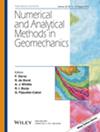考虑独立桩长和嵌岩深度的层状饱和软岩土体与群桩的相互作用
IF 3.6
2区 工程技术
Q2 ENGINEERING, GEOLOGICAL
International Journal for Numerical and Analytical Methods in Geomechanics
Pub Date : 2025-06-02
DOI:10.1002/nag.4014
引用次数: 0
摘要
本文研究了考虑独立桩长和嵌岩深度的层状饱和软岩土体与群桩之间的相互作用。同一桩的模型是基于一维压杆单元和三节点杆单元。然后用有限元法推导了群桩整体受力平衡方程。在考虑单桩独立长度存在的情况下,对嵌岩单桩的岩土质量刚度矩阵方程进行了扩展,并在边界元法(BEM)的基础上推导了群桩的整体岩土质量刚度矩阵方程。结合刚性承台的受力平衡和位移协调条件,采用有限元-边界元耦合方法,进一步得到了独立嵌岩桩群的解。通过与已有解和ABAQUS的验证,验证了本文理论和方法的正确性。进一步分析了层状饱和软岩土体中独立嵌岩桩群响应的主要影响因素。本文章由计算机程序翻译,如有差异,请以英文原文为准。
Interaction Between Layered Saturated Soft Rock–Soil Mass and Pile Groups Considering Free‐Standing Length and Rock‐Socketed Depth
This paper investigates the interaction between layered saturated soft rock–soil mass and pile groups considering free‐standing length and rock‐socketed depth. The modeling of the identical pile is on the basis of one‐dimensional compression bar with a three‐node bar element. The global force balance equation for the pile group is then derived using the finite element method (FEM). Taking the existence of free‐standing length of the single pile into account, the rock–soil mass stiffness matrix equation for a rock‐socketed single pile is expanded, and the global rock–soil mass stiffness matrix equation for the pile group is further derived on the basis of the boundary element method (BEM). Referring to the coupled FEM‐BEM, the solution for the free‐standing rock‐socketed pile group is further achieved by combining the conditions of force equilibrium and displacement coordination for the rigid cap. The correctness of the theory and method in this study is confirmed by validating with the existing solutions and ABAQUS. Further analyses are given to investigate the impact of key factors on the response of a free‐standing rock‐socketed pile group in the layered saturated soft rock–soil mass.
求助全文
通过发布文献求助,成功后即可免费获取论文全文。
去求助
来源期刊
CiteScore
6.40
自引率
12.50%
发文量
160
审稿时长
9 months
期刊介绍:
The journal welcomes manuscripts that substantially contribute to the understanding of the complex mechanical behaviour of geomaterials (soils, rocks, concrete, ice, snow, and powders), through innovative experimental techniques, and/or through the development of novel numerical or hybrid experimental/numerical modelling concepts in geomechanics. Topics of interest include instabilities and localization, interface and surface phenomena, fracture and failure, multi-physics and other time-dependent phenomena, micromechanics and multi-scale methods, and inverse analysis and stochastic methods. Papers related to energy and environmental issues are particularly welcome. The illustration of the proposed methods and techniques to engineering problems is encouraged. However, manuscripts dealing with applications of existing methods, or proposing incremental improvements to existing methods – in particular marginal extensions of existing analytical solutions or numerical methods – will not be considered for review.

 求助内容:
求助内容: 应助结果提醒方式:
应助结果提醒方式:


